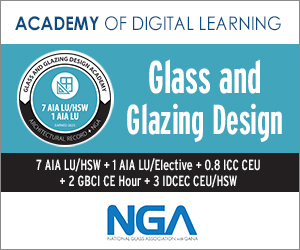School Buildings in 2015: Designing for Students
Learning Objectives:
- Explore the basic condition of schools in the United States and the range of issues among the states related to new and existing school buildings.
- Investigate six fundamental student performance concerns related to the design of school buildings.
- Assess various strategies that can be used to successfully improve the quality of learning environments.
- Recognize and identify programs and resources to assist in healthier, more productive, and more efficient learning environments.
Credits:
The design of K-12 school buildings has garnered a lot of attention in recent years, focused on ways to create genuinely better learning environments for students. Those involved in working with school boards, administrators, and teachers have no doubt engaged in discussions and debates over the need for optimized instructional spaces, healthier and safer buildings, reduced energy usage, better environmental integration, and other factors contributing to better student performance overall. These issues aren't limited to new construction since they are often primary drivers of modernization programs in existing school buildings as well. Fortunately, the interest in these issues has spawned some research and performance-based programs to help inform all those involved when it comes to making design decisions. This information allows architects to consider various available design strategies to help create truly effective, modern learning environments where students can flourish.
Context: School Status and Trends
Industry sources generally acknowledge that school construction is often the largest sector of total nonresidential construction put in place in any given year. An organization known as the 21st Century School Fund has founded a collaborative program known as Building Educational Success Together (BEST) that has reviewed and compiled information based on U.S. Census data, available state data, and direct surveys to document some specific details. In 2011, they published a summary of Public School Facility Infrastructure which indicates that nearly 90 percent of all of the 55.5 million school-age children in the U.S. attend nearly 100,000 public schools in the U.S. More precisely, they count 98,706 PreK-12 public schools (including 4,694 public charter schools) representing an estimated 6.6 billion gross square feet of existing space and over 1 million acres of land or site areas. Since the BEST focus is on the condition of these facilities, they cite a significant backlog of deferred maintenance and capital improvements on the order of an estimated $271 billion or approximately $4,883 per student. They further estimate that since 1999, an average of 80 percent of the capital outlay of school districts has been on new construction and additions with 20 percent on existing buildings.
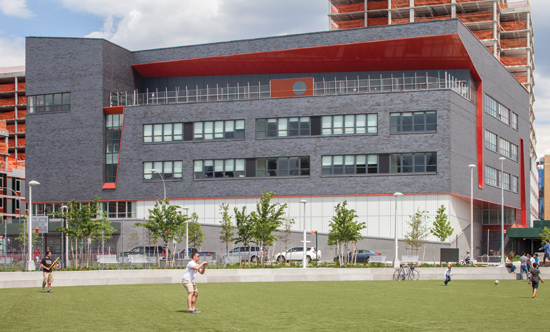
Photo courtesy of Endicott Clay Products
Modern school design increasingly needs to address a variety of concerns related to the experience of students in and around those buildings such as Hunter’s Point in Queens, New York, designed by FXFowle.
Turning to future outlooks, other sources suggest that enrollment will continue to grow on the order of 2.5 million more students through 2018 with annual capital spending nationally projected on the order of $25 billion or more each year through then. Observable trends include a growth in school additions and renovation to help address potential overcrowding. There has also been a clear trend observed in school designs becoming more flexible and adaptable for changing demographic and classrooms needs. In response to incidents of violence and other security concerns, there has also been a growing effort to create schools that are safer.
Green and sustainable design has also been a significant, ongoing movement that is expected to continue in schools, creating spaces with more connection to the natural environment, more natural light, healthier indoor air, and better energy performance. This effort is boosted by programs such as the LEED® for Schools program from the U.S. Green Building Council (USGBC). A related USGBC effort is the national Center for Green Schools which helps educate designers and educators on specific characteristics for safe, healthy schools including a program to bring sustainability education into the classroom. In 2012, the Center for Green Schools partnered with the McGraw Hill Financial Research Foundation and published “The Impact of School Buildings on Student Health and Performance.” It was based on a 2006 National Research Council report entitled “Green Schools: Attributes for Health and Learning.” Both documents use six categories related to student experiences in school buildings and cite research studies as their basis. We will use the same six categories in the following sections to illustrate not only the connections between student performance and their surroundings, but also to suggest some potential design strategies and examples of their implementation. In all cases, the focus is on improving the conditions in which everyone involved can thrive.
1. How Students Think and Learn
Connecting good school facilities with good student learning outcomes is a complicated proposition at best since there are many building variables and many human variables that can come into play. Nonetheless, there have been some observational studies that have produced some promising findings. For example, a study in one school district in Connecticut found that student test scores increased notably in schools after school construction projects were undertaken. (Neilson and Zimmerman, 2011.) The researchers accounted for differences in socioeconomic levels and other confounding factors to reach their conclusions so it is reasonable to infer that some direct correlation exists between the improved conditions and student test taking, although they cite the need to undertake a larger study on a national scale. Other observational studies have connected environmental factors with students' abilities to be fully alert or simply attend classes, both of which have obvious direct impacts on learning.
So what general design strategies would help students be more alert, or simply more engaged to think and learn better? The trend for more flexible spaces may play directly into this. If a learning environment can be easily and readily adapted to meet the particular needs of a grade level, a specific class, or even a particular student, might it not follow that their engagement with the environment directly facilitates engagement with learning?
Movable Walls
One strategy is to incorporate movable wall systems instead of purely fixed walls into the design of a learning area to create a truly dynamic and flexible learning environment. Opening a movable wall can create a shared space between two adjacent classrooms while closing the wall can separate and isolate them when needed. Similarly, movable wall systems can open up multiple classrooms or grades to a common area that is shared for group learning activities. This design strategy offers the benefits of allowing the same spaces to be used for smaller project-based learning activities or for larger common exercises where students work together on a range of activities, utilizing shared resources such as technology centers and presentation areas. Creating such flexible classroom configurations can optimize limited floor space, allowing for potentially less square footage and reduced construction costs. In addition, such multi-use spaces can contribute to reduced operating costs since teachers can share resources, cross-collaborate, and create a more efficiently run school.
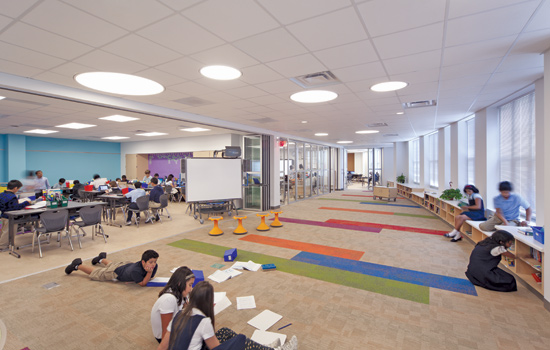
Photo courtesy of NanaWall Systems
Movable walls provide flexible, collaborative spaces that enhance learning at the Booker T. Washington STEM Academy in Champagne, Illinois, by CannonDesign.
This movable, flexible wall approach was employed at the Booker T. Washington STEM Academy in Champagne, Illinois. Serving 225 students, the school is separated into three academies with each grade further stratified into three learning studios which share a communal gathering space. The architectural firm of CannonDesign determined that the use of movable glass wall systems allowed the three studios to either function as separate learning environments or to open up and share the larger communal space. As observed by Stuart Brodsky, AIA, LEED AP, an associate principal at CannonDesign, “The movable glass walls enable multiple room configurations and sizes without building additional space. This flexibility allows teachers to gain access to shared resources and adapt space for small and large groups as well as project-based learning activities.” They also allow each learning studio to maximize activities within the communal gathering and project workspace—what CannonDesign calls a “piazza for discussion and collaboration.” This open-plan layout is meant to mirror professional settings, helping students prepare for real-world future collaborations.
Creative Classroom Furnishings
For students to learn and think in a classroom setting, the furnishings that they use need to work with their learning styles and the teaching style of the instructor. In addition, all furniture has become increasingly focused on good ergonomic design using environmentally friendly materials and manufacturing processes. Recognizing these needs, the school furniture industry has responded in dramatic fashion, offering unique combinations of seating, work surface, and storage options that enable the end users to effectively and efficiently create their own environments. This design strategy is not about reinventing the classroom as much as it is about blending historic educational values and strategies with flexibility and creative learning environments. The end goal remains the creation of healthier, higher-performing learning environments so the selection of furnishings should reflect that goal. It should be noted that there are lines of educational furnishings that directly respond to the principles and design guidelines of USGBC, the Center for Green Schools, and other such national programs.
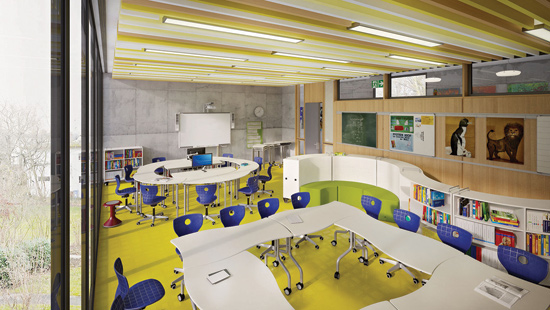
Photo courtesy of VS America
Flexible and movable furniture systems empower both teachers and students to create classroom environments that directly suit the teaching and learning needs of a particular class for different subjects or activities.
The impact on design from flexible furniture systems means that classrooms don't need to be restricted to a planning process based on rows of desks alone. Rather, the room becomes an enclosure that allows for variable forms and shapes to promote class-wide learning or separation into smaller groups within the classroom. When these new and variable environments are created, it is possible to think in terms of a holistic approach to design and how it fits with educational goals and styles. According to David A Stubbs II, owner of Cultural Shift and the designer of Shift+, when teachers and students are empowered to adjust, move, and otherwise rearrange the furniture to suit different needs, it has been observed that 100 percent engagement has occurred. This full level of engagement in combination with minimalized distractions, has been shown to demonstrate improved learning and more effective teaching strategies.
Notice
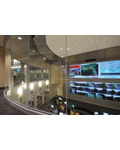
www.pyrosafeglass.com

www.BisonIP.com
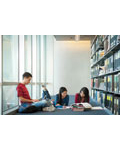
www.certainteed.com/airrenew

www.dorma.com/
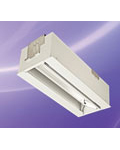
www.elplighting.com/
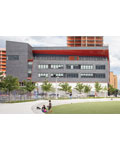
www.endicott.com/
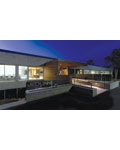
www.SunGuardGlass.com/
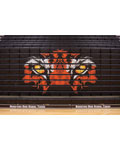
www.husseyseating.com/
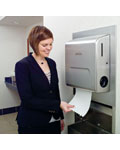
www.kcprofessional.com/
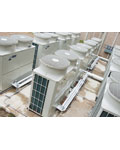
www.MitsubishiPro.com/
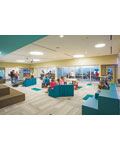
Architect: Hollis + Miller Architects
www.NanaWall.com/
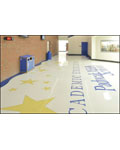
www.ntma.com/
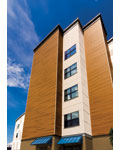
www.nichiha.com/
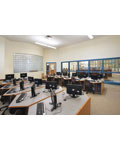
www.pittsburghcorning.com/
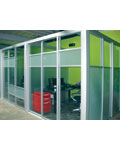
www.spaceplus.com/

www.us-concrete.com/aridus/
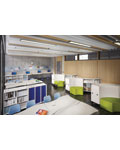
www.vs-network.com/





